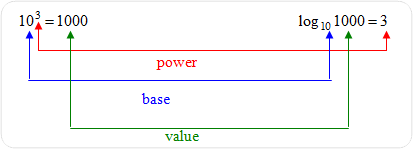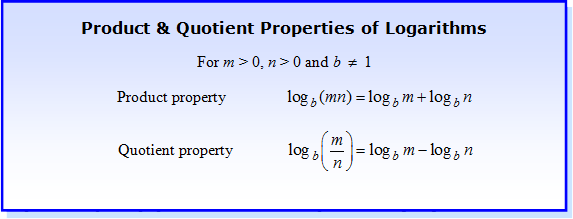LOGARITHMIC FUNCTIONS

This unit is about the properties of exponential and logarithmic functions and solving equations using these properties. Common logarithmic functions are used to solve exponential and logarithmic equations. The change-of-base formula is used to evaluate exponential and logarithmic equations. Applications of logarithmic functions include the pH scale in chemistry, sound intensity, the Richter scale for earthquakes, and Newton’s law of cooling.
Note: The picture shows San Francisco in 1906 after a devastating earthquake.
Logarithmic Functions
The logarithm of a number is the exponent to which a fixed value, called the base must be raised to produce that number. For example, the log of 1000 to base 10 is 3 , because 1000 is 10 to the third power.
exponential form |
logarithmic form |
|
 |
||
base power = value |
logbase value = power |
|
In general, the logarithmic function is the inverse of the exponential function.
A logarithm base b of a positive number x satisfies the following definition.
 |
Here is an animation that will help with understanding what a log is.
The expression, logb x, is read as “log base b of x.” In other words, the logarithm y is the exponent to which b must be raised to get x.
*Because y = logb x is the inverse of y = bx and y = logb x is a function, the exponential function y = bx is a one-to-one function**.
**Meaning: For each element in the domain (x-values), there is exactly one corresponding element in the range (y-values).
| Example #1: 53 = 125 becomes log 5 125 = 3 |
More examples: The black (dark) print represents what is given; the red (light) print represents the results.
 |
Stop! Go to Questions #1-3 about this section, then return to continue on to the next section.
One-to-One Property of Exponents
Let's examine how the One-to-One Property of Exponents can help in solving logarithmic equations expressed in exponential form.
 |
| Here is an animation that will help with understanding the One-to-one property. |
Example #1: Solve log 2 1 = r for r.
|
Example #2: Solve log v 32 = 5 for v.
|
Example #3: Solve log b 9 =
|
| Let's practice evaluating a few logarithms by applying the One-to-One Property of Exponents. |
![]() Evaluate log 2 8 = x
Evaluate log 2 8 = x
x = 3 because 23 = 8
"Click here" to check the answer.
![]() Evaluate log 9 9 = v
Evaluate log 9 9 = v
v = 1 because 91 = 9
"Click here" to check the answer.
![]() Evaluate log 7 49 = q
Evaluate log 7 49 = q
q = 2 because 72 = 49
"Click here" to check the answer.
![]() Evaluate log 2
Evaluate log 2 ![]() = m
= m
m = –2 because 5 –2 = 1/25
"Click here" to check the answer.
Stop! Go to Questions #4-7 about this section, then return to continue on to the next section.
Graphs of Logarithmic Functions
To sketch the graph of a logarithmic function, use the fact that the logarithmic function is the inverse of the exponential function.
| Remember that the inverse of a function is obtained by switching the x and y coordinates. This reflects the graph about the line y = x. |
The table below shows how the x and y coordinates of the points on the exponential curve y = 2 x can be switched to find the coordinates of the points on the logarithmic curve y = log 2 x.
  |
Let's examine the logarithmic function closely.
Domain (x-coordinates) of a Logarithmic Function |
Look at the left side of the logarithmic graph (blue). Notice that the x‑coordinates of the points are very close to zero, but never equal zero or cross over the y-axis. On the right side of the graph, the x-coordinates of the points grow infinitely.
Thus, the domain for the logarithmic function is x > 0.
Range (y-coordinates) of a Logarithmic Function |
Since the y-coordinates of the points are unrestricted and can be infinitely small and infinitely larger, the range of a logarithmic function is all real numbers.
Features of a Logarithmic Function |
-There is no y-intercept. -The vertical asymptote is x = 0. *Note: An asymptote is a line that a graph approaches as x or y increases in absolute value. -A logarithmic function has no horizontal asymptote. -The x-intercept is 1. -The function is increasing over the domain. *Note: If the base is between 0 and 1, the function decreases over the domain. |
Translating a Logarithmic Function |
Knowing the shape of a logarithmic graph, it can then be shifted vertically and/or horizontally, stretched or compressed, and reflected.
The function logb x is the parent graph for the logarithmic function.
When working with the logarithmic function, y = logb (x – h) + k, the graph of the parent function, y = logb x, can be translated horizontally by h units and vertically by k units.
The a in the standard form of a logarithmic function y = a logb (x – h) + k results in a stretch (if |a| > 0), a compression
(if 0 < |a| <1 ) or a reflection (if a < 0).
Example #1: How does the graph of y = log3 (x + 2) + 4, compare to the graph of the parent function
y = log3 x? State the domain, range and identify the asymptote (the vertical line that the graph approaches).
The graph below shows the horizontal (–2) and vertical (+4) shifts.
|
|||||||||||||||||
Example #2: How does the graph of y = 3log4 (x) – 2, compare to the graph of the parent function y = log4 x? State the domain, range and identify the asymptote (the vertical line that the graph approaches).
The graph below compares the parent function (red) to a function that shows just the compression a = 3 (blue), and then the entire given function (green) which is compressed by 3 and shifted down two units.
|
|||||||||||||||||
Stop! Go to Questions #8-11 about this section, then return to continue on to the next section.
Properties of Logarithmic Functions
Logarithms, by definition, are exponents; thus, the properties of logarithms are similar to the properties of exponents.
 |
| Product Property: The log of a product is equal to the sum of the log of the first base and the log of the second base. Quotient Property: The log of a quotient is equal to the difference of the logs of the numerator and denominator of the fraction that represents the division. |
Example #1: Rewrite the log expression as log5 2 + log5 6x as one log.
|
Example #2: Rewrite the log expression as log812 – log84 as one log.
|
Example #3: Rewrite the log expression as logb4x – logb3y + logb y as one log.
|
 |
Power Property: The logarithm of a power is equal to the power times the log of the base. |
Example #4: Evaluate: log3 27 8
|
 |
An exponential function and logarithmic function with the same base are inverses of each other.
Example #5: Simplify:
Therefore the value of |
Example #6: Simplify: log2 32 –
Therefore the value of log2 32 – |
 Here is an animation that will help with understanding the One-to-one Property of Logarithms. |
If the bases of equivalent logarithms are the same, then the values are equal.
Example #7: Solve for x: log 2 (2x 2 + 8x – 11) = log 2 (2x + 9)
|
Stop! Go to Questions #12-21 about this section, then return to continue on to the next section.
Applications of Common Logarithms
A common logarithm is a logarithm with base 10. Common logarithms, log 10 x can be written simply as log x, without showing the 10.To solve equations where x is an exponent:
 |
Example #1: Solve for x: 3x – 4 = 5x –1
|
*Use a graphing calculator (like TI-83 or TI-84) to solve logarithmic equations. Make sure to put parentheses around the entire numerator and the entire denominator when entering numerators or denominators.
 |
The change-of-base formula works well with graphing calculators because the default base for logs on a calculator is 10. The value of a log in a different base (b) can be found by taking the log of the value (x) and divide it by the log of the base (b).
Example #2: Evaluate: log 8 97
|
Example #3: Evaluate: log 7
|
*Use the graphing calculator to find the value of an expression using the change-of-base formula.
Logarithms and Earthquakes |
 The Richter scale is a logarithmic scale used to express the total amount of energy released by an earthquake. Each number increase on the Richter scale indicates an intensity ten times stronger. For example, an earthquake of magnitude 5 is ten times stronger than an earthquake of magnitude 4. An earthquake of magnitude 6 is 10 × 10, or 100 times stronger. In general, a measure of under 5 on the Richer scales is considered a minor earthquake, while a measure over 7 indicates major destruction. The Richter scale is a logarithmic scale used to express the total amount of energy released by an earthquake. Each number increase on the Richter scale indicates an intensity ten times stronger. For example, an earthquake of magnitude 5 is ten times stronger than an earthquake of magnitude 4. An earthquake of magnitude 6 is 10 × 10, or 100 times stronger. In general, a measure of under 5 on the Richer scales is considered a minor earthquake, while a measure over 7 indicates major destruction. The formula, |
| Example #4: In 1906, an earthquake in San Francisco was estimated to have a magnitude of 7.8. In 1989, an earthquake of magnitude 6.9 shook San Francisco. How many times more intense was the 1906 earthquake than the 1989 earthquake? Note: The overview picture shows San Francisco in 1906 after the earthquake.
The 1906 San Francisco earthquake was 8 times more intense than the 1989 earthquake. |
Stop! Go to Questions #22-32 about this section, then return to continue on to the next section.
Solving an Exponential Equation with a Graph
A graphing calculator can also be used to solve exponential equations.
Example #1: Solve 2x = 300 using a graphing calculator.
Adjust the window to find the point of intersection. The solution is x ≈ 8.23. |
To determine the point of intersection, trace to the intersecting point or do the following:
| -On the graphing calculator, enter 2ND CALC 5: intersect. -Press ENTER to accept the default for the First curve. Press ENTER again to accept the default of the Second curve. Press ENTER a third time and accept the calculator's Guess. Press ENTER one final time to view the coordinates of the point of intersection. The solution is x ≈ 8.23. This is the x-coordinate of the point of intersection. |
Use the questions below as a guide, if necessary, to set up the window on the graphing calculator.
![]() What are reasonable domain values?
What are reasonable domain values?
From Xmin = 0 to Xmax = 20
"Click here" to check the answer.
![]() What are reasonable range values?
What are reasonable range values?
From Ymin = 0 to Ymax = 400
"Click here" to check the answer.
![]() What are reasonable scale values?
What are reasonable scale values?
From Xscl = 20 to Yscl = 20
"Click here" to check the answer.

Stop! Go to Questions #33-35 to complete this unit.











